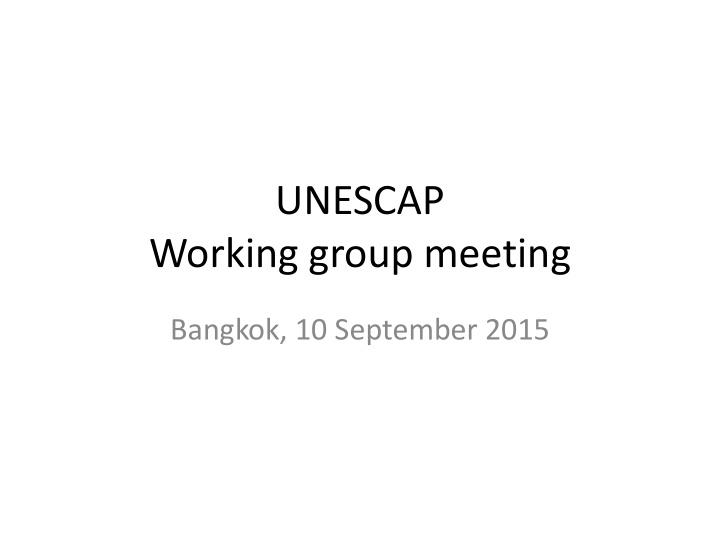



UNESCAP Working group meeting Bangkok, 10 September 2015
OECD (2015)Trade Policy Papers 181
Study • Explore ICT requirements and gaps to implement Trade and Transport Facilitation systems • ICT requirements are – IT system architecture, – legal and policy framework, – human resources and knowledge resources, organisational framework and development. • Target group: ICT policymaker namely in LDCs and LLDCs
Questions to be answered 1. Where is the IT TTF potential? 2. What are the challenges for a more effective deployment of IT for TTF purposes? 3. What needs to happen to use IT effectively? 4. What are particular developing countries challenges?
1: Potential • Business areas – Risk Management – Transit facilitation – Guarantee management (for transit) – Licenses, certificates and quota management – Coordinated Border Management – Transparency / Administrative Facilitation – Cross-border exchange of information – Customs processing – Decision making support
…5 min
2: Challenges? • Brainstorming • Think of factors that currently hinder using the full potential of IT? • Write every idea on a card
2: Challenges?
3: What needs to happen? • ICT Architecture: Modernisation and Integration • ICT Strategy and organisation
ICT Traditional Silos, PC-centric and client – server architecture • Melt the silos - “boil the ocean” approach • Standardize on a common technology and infrastructure platform, rather than rely on a stitched together collection of legacy silos • Innovate key processes to improve the value or drive down cost • Propagate these changes across the enterprise, via the common technology platform, to convert localized improvements into strategic advantage
• The virtualization concept results in hardware topology independence • Share the ICT resource pools • Comply with regulatory requirements as centralized data, applications and services • Service Oriented Architecture (SOA) pattern in software design in which application components provide services to other components via a communications protocol (layer) • ICT modular deployment infrastructure in combination with virtualization
• The Business Architecture, driven by business strategy, organizational and business processes; • The Applications / Service Architecture, which outlines the applications /services to be integrated and deployed, their boundaries and dependences with the business processes; • The Data Architecture, defining the logical and data layer; • The Infrastructure Architecture, that consists of hardware infrastructure projected to support the business, application and data architectures.
The TTF Enterprise Portal is the single access point that serves as the entry point of transactions and communication layer for the trades
Complex event-driven processing system
Law Enforcement IT System
Integrated Risk Management System Architecture
Enterprise Content Management Challenges Effective disk utilization is <50%, with 85% of information is unstructured, 20-40% wasted space outside a database 30% of user’s time is spent 30%-40% of users' can’t find searching for information information they need More than 60 % of business is conducted Enterprises have to think in on unstructured information terms of the TB’s IT Department searches to reduce costs, drive strategic standards, and do more with less
ICT Organisation • Organisational model that breaks silo functions without centralising in a single new organisation • ICT strategy that links business to IT needs and provides a coherent framework for planning and budgeting • Continuous investment into training and capacity building of staff • Total cost ownershipconsiderations and standardized pricing model
Legal framework • Appropriate protection of data and privacy protection in an electronic environment • Legal framework that enables exchange of data • Equivalence of paper and electronic documents • Recognition of e-signature across borders
4: DC countries challenges ? Limiting factors Modernization & Integration Enabling factors
Recommend
More recommend